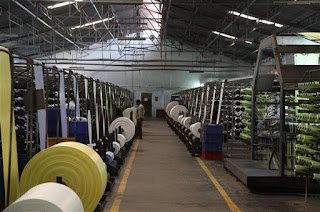Shrinkage test of woven sack tapes
1. Object of Test
To determine the degree of shrinkage
that will occur when polyolefin tape is subjected to heat for a specified
length of time.
2. Method PE
5 randomly selected tape samples are cut
to the exact length of 100 cm (39.37”).
These are then immersed in a water bath maintained at a constant
temperature of 212°F (100°C) for 1 minute.
The tapes are then removed from the bath and are allowed to cool and
dry. The tapes are then measured and
percentage of shrink is calculated from the difference between the original
length and the reduced length after the water bath, all divided by the original
length.
Method PP (polypropylene) tape
5 randomly selected tape samples are cut
to the exact length of 100 cm (39.37”).
These are then put in an oven at a constant temperature of 270°F (132°C)
for a duration of 15 minutes. The tapes
are removed from the oven and allowed to cool.
The tapes are then measured and the percentage of shrink is calculated
from the difference between the original length and the reduced length after
the oven, all divided by the original length.
4. Apparatus
a)
A
100 cm base sample cutting board.
b)
Cutting
blade.
c)
Magnetized
pot (for PE tape only)
d)
Induction
hot plate. (for PE tape only)
e)
Tongs. (for PE tape only)
f)
Oven
at 270°F. (for PP tape only)
g)
Stop
clock.
h)
Calibrated
Ruler with divisions in cm.
a)
Using the cutting board and
taking care not to stretch the tape, cut from 5 randomly selected packages of
tape, exact 100 cm lengths.
b)
Immerse the samples in a
previously prepared bath of boiling water.
c)
After a 60 second period, remove
the samples from the water using the tongs provided. Allow the tapes to cool and dry.
d)
Measure the length of the tapes
and compare to the original length of 100 cm.
The percentage of shrink is equal to the difference between lengths
divided by the original length.
e)
Record under the shrinkage
column of the Quality Control Tape Results sheet) the individual shrinkage of
each tape and the average of the five values.
f)
Check the results against the
average maximum percentage of shrink listed in the applicable product specification
(TD 900 series).
Procedure PP tape
a) Using the cutting board and
taking care not to stretch the tape, cut from 5 randomly selected packages of
tape, exact 100 cm lengths.
b) Put the samples in the oven at
270°F and start the time clock.
c) After 15 minutes, remove the
samples from the oven and allow them to cool.
d) Measure the length of the tapes
and compare to the original length of 100 cm.
The percentage of shrink is equal to the difference between lengths
divided by the original length.
e) Record under the shrinkage column
of the Quality Control Tape Results sheet the individual shrinkage of each tape
and the average of the five values.
f) Check the results against the
average maximum percentage of shrink listed in the applicable product
specification (TD 900 series).





because when I use a thread with a higher denier the fabric gets bigger?
ReplyDeleteBecause when I use a weft of a higher denier it increases the width of the bag? We all item use weft 1260 denier but when that increase to 14000 por more increase the width of the woven sack
ReplyDeleteHow do I calculate how much amount of lamination is to be done on fabric and what will be the weight of on the bag? Say for example we say that 4 gram plus lamination then is 4 gram per square inch? and what will be the weight when lamination is done on the bags?
ReplyDeletehttps://wovensacksfromsuraj.blogspot.com/2024/03/coated-bag-planning-calculator.html
DeleteI have questions for barzing bag after a fillng material,& in aweek.Pls advice me for solving this problem.
ReplyDeleteGreat Info and Thanks for sharing info PP Woven sacks
ReplyDeleteOremplaQalso Beth Johnson https://wakelet.com/wake/QP_ej1f_9OQi8_b39Xvga
ReplyDeletelamerere
lietoQcars_be Jessica Wright Link
ReplyDeleteAdobe Photoshop
Unreal Commander
workpulinthumb
what will be the shrinkage of pp rafia tape with 100 dig. boiled water till 15 min.
ReplyDeletebut sir ASTM D name
ReplyDeleteAs a manufacturer of chemical products, we PE Bags/PE Liners rely on for their excellent resistance to moisture, chemicals, and contamination. These liners ensure that our products remain safe and intact throughout the entire transport process.
ReplyDeleteThe Polyethylene high density sheet are high-performance plastic sheets made from High-Density Polyethylene. Known for their strength, flexibility, and resistance to moisture, chemicals, and impact, they are ideal for use in construction, agriculture, packaging, and marine applications. Lightweight and easy to fabricate, HDPE Sheets offer a durable solution for both indoor and outdoor use.
ReplyDeleteThe PE bag manufacturer are flexible, durable plastic packaging solutions made from polyethylene, designed to protect products from moisture, dust, and contamination. Available in various sizes and thicknesses, they are widely used in industries such as food, pharmaceuticals, agriculture, and chemicals for safe storage, lining containers, and transporting goods efficiently.
ReplyDeleteThis is a very clear explanation of how shrinkage testing impacts the quality of woven sack tapes. It’s true that even a small variation can change the strength and durability of the final woven fabric, especially in heavy-duty packaging. In our work, we often compare shrinkage results with loom settings to reduce wastage. For anyone looking deeper into woven fabric properties, here’s a detailed reference on PP woven sack fabric
ReplyDelete